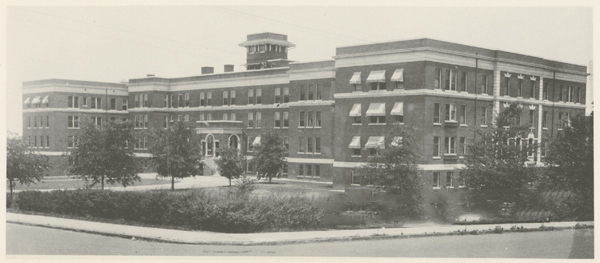Advancement School
 The North Carolina Advancement School in Winston-Salem was one of the education initiatives of Governor Terry Sanford (1961-65), who conceived it as a counterpart to the Gifted and Talented Programs begun in 1962. With North Carolina's school dropout rate among the nation's highest at 40 percent, Sanford wanted to address the needs of academic underachievers-those with average or above average abilities who were nevertheless performing poorly in school and likely to drop out. Sanford charged Ralph McCallister, formerly of Syracuse University and the Chautauqua Institute, with assembling educational experts to design a strategy to keep such underachievers in school. With a planning grant from the U.S. Office of Education, McCallister, working principally with Sanford adviser John Ehle and Harold Howe II, former superintendent of public schools in Scarsdale, N.Y., developed and proposed the Advancement School.
The North Carolina Advancement School in Winston-Salem was one of the education initiatives of Governor Terry Sanford (1961-65), who conceived it as a counterpart to the Gifted and Talented Programs begun in 1962. With North Carolina's school dropout rate among the nation's highest at 40 percent, Sanford wanted to address the needs of academic underachievers-those with average or above average abilities who were nevertheless performing poorly in school and likely to drop out. Sanford charged Ralph McCallister, formerly of Syracuse University and the Chautauqua Institute, with assembling educational experts to design a strategy to keep such underachievers in school. With a planning grant from the U.S. Office of Education, McCallister, working principally with Sanford adviser John Ehle and Harold Howe II, former superintendent of public schools in Scarsdale, N.Y., developed and proposed the Advancement School.
The Advancement School, like the North Carolina School of the Arts and the Governor's School for the Gifted, was to be a residential facility and a teaching laboratory and research center with three fundamental tasks: to assemble existing materials and techniques used to teach students achieving from one to three grades below national norms, to develop new materials and techniques to further students' achievement levels and educational aspirations, and to work with classroom teachers so that materials could be transferred from the residence-school setting to local schools.
In a unique arrangement, the Learning Institute of North Carolina (LINC), headed by Howe and located at the Quail Roost Conference Center in Rougemont, contracted with the State Board of Education to operate the Advancement School until 30 June 1967. With a combination of state funds and grants from the U.S. Office of Education and the Carnegie Corporation, Advancement School director Gordon L. McAndrew leased the vacated City Memorial Hospital from Winston-Salem. The Advancement School opened its doors to 82 boys for a six-week pilot session on 8 Nov. 1964.
In addition to instructional techniques, the Advancement School pioneered in race relations. Ten years after the landmark Supreme Court case Brown v. Board of Education, only about 6 percent of the state's black children attended integrated schools. In the Advancement School's pilot session, there were 51 white children, 22 blacks, and 9 Native Americans. During the regular sessions, African American enrollment averaged 25 percent to 30 percent of the student body. The Advancement School established firm ties with schools in Hoke and Robeson Counties, and Native American enrollment in at least one session constituted about 40 percent of the student body. Donald G. Hayes, the assistant director, made room assignments without consideration to racial identity, a practice continued throughout the life of the school.
From November 1964 through June 1967, the Advancement School enrolled 2,331 students from 133 of the state's 169 school systems. Although the legislature approved continuation of the Advancement School beyond 1967, it drastically reduced the budget and placed the school under the supervision of the State Board of Education. The school enrolled only 144 students in January 1968, and after the spring 1969 session, enrollment dropped below 100. A nonresidency component was added, and after 1971 the school only enrolled day students. In its final three years, the Advancement School continued as a year-round day school for Winston-Salem students. In 1975 a budget crisis forced the legislature to make massive cuts. The state provided the Advancement School only enough funds to prepare a final report. A skeleton staff moved to Graylyn Estate on the campus of Wake Forest University, where it conducted a few more workshops, completed its report, and closed the school in 1976.
References:
John N. Bridgman Jr. and Ernestine M. Godfrey, The Investigation and Treatment of Underachievement in North Carolina: Final Report, 1964-1976: The North Carolina Advancement School, Winston-Salem (1976).
Chester Davis, "North Carolina Advancement School: A New Approach to the Student Who Can Do . . . but Doesn't," Southern Education Report (July-August 1965).
Terry Sanford, But What about the People? (1966).
Additional Resources:
North Carolina Advancement School/Learning Institute of North Carolina, 1961-1967 and Undated, Ralph McCallister Papers, 1936-1985, UNC Libraries: http://www.lib.unc.edu/mss/inv/m/McCallister,Ralph.html#d1e647
Advancement School by Godon McAndrew: http://www.eric.ed.gov/ERICWebPortal/search/detailmini.jsp?_nfpb=true&_&ERICExtSearch_SearchValue_0=ED002671&ERICExtSearch_SearchType_0=no&accno=ED002671
Thompson, Charles, et al. "The North Carolina Advancement School 1964-1967." 1967. ERIC No. ED 023 762. http://eric.ed.gov/?id=ED023762 (accessed May 29, 2015).
Image Credit:
"City Memorial Hospital, 1924." Image courtesy of Digital Forsyth. Available from http://www.digitalforsyth.org/photos/4720 (accessed November 8, 2012).
1 January 2006 | Kuhl, Paul E.